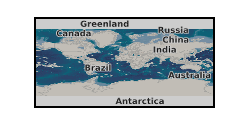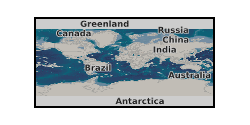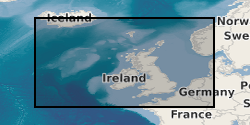JPG
Type of resources
Topics
Keywords
Contact for the resource
Provided by
Years
Formats
Representation types
Update frequencies
Scale
-

This dataset contains folders of field photographs. Photographs were collected from 4 different field locations - Warton, Glengarnock, Derwent Howe, Harrington. There is a folder for each location, and within each of those there are folders labelled by whether they are contextual, or of samples. The data was collected between 2021 and 2023. The data was collected for the purpose of documenting the appearance and characteristics of samples collected. The data was collected by John MacDonald and Robin Hilderman (University of Glasgow) who retain the original data.
-

These spatial and temporal image datasets are of mixing fluids in a dyke-like (slot) geometry investigated using low-temperature laboratory experiments which are described in the paper Analogue experiments to investigate magma mixing within dykes (Havard et al., in review in Bulletin of Volcanology, January 2025). The experiments are low-temperature analogue models of magma mixing within dykes and are dynamically scaled to the natural system. Seven unique experiments using seven different miscible fluid pairs, representing two magmas of differing composition, were conducted at the University of Liverpool. The miscible fluid pairs were (and the shortened experiment name is): water and diluted glycerol (ExpW1); water and pure glycerol (ExpW2); water and glycerol mixed with golden syrup (ExpW3); water and pure golden syrup (ExpW4); diluted glycerol and pure glycerol (ExpD1); pure glycerol and diluted golden syrup (ExpG1); pure glycerol and pure golden syrup (ExpG2). The experiment setup consisted of the lower density fluid placed above the higher density fluid in the tank apparatus, then the tank was inverted to initiate the interaction between the fluids. The raw data is a temporal series of photographs (JPGs) collected over the course of each experiment located within the subdirectories “Raw”. The raw data is processed using the scripts accompanying the dataset to show how density and mixing evolves spatially and temporally within the slot. Further details are available in the directory metadata file.
-

Multiple calibrated laboratory images of experiments to determine leakage rates through faults and geological heterogeneities. Two sequences of images, and associated movie (avi file) depicting laboratory fault experiments as described in; Gilmore, K., Sahu, C., Benham, G., Neufeld, J., & Bickle, M. (2022). Leakage dynamics of fault zones: Experimental and analytical study with application to CO2 storage. Journal of Fluid Mechanics, 931, A31. doi:10.1017/jfm.2021.970
-

Pictures of sulphides and trace element concentrations from ore minerals in the El Teniente porphyry Cu-Mo deposit, Chile. Samples were picked for analysis from the Natural History Museum London’s ore collection. This data contains petrological photographs and trace element concentration of ore minerals. This data was collected as part of the TeaSe consortium NERC grant in order to determine the concentration and hosting of critical and precious metals in various types of ore deposits and barren rocks from different geological environments. This data was collected and interpreted by researchers at Cardiff University.
-

The Marine Photographs Archive held by BGS includes photographs of hydrocarbon well and (non-hydrocarbon) marine boreholes, cores and other samples. There are also photographs of the seabed and survey operations. The photos are primarily for the UKCS (United Kingdom Continental Shelf) and surrounding areas and date from the 1970s onwards. The photographs, which are a mix of prints, negatives and digital are applicable to a wide range of uses including environmental, geotechnical and geological studies. There are also some x-rays of cores.
-

A core scanning dataset from the Keyworth D borehole 3. This borehole was drilled onshore at the British Geological Survey (BGS) headquarters in Keyworth, Nottinghamshire, UK, in March 2024 as part of BGS’s geothermal heat pump project funded by the Natural Environmental Research Council (NERC). The 238.5 m-long Mercia Mudstone core succession was scanned for radiographic images (RAD) and geophysical property data (MSCL-S) using the Core Scanning Facility (CSF) at the British Geological Survey (BGS).
-

An initial core scanning dataset from the TH0424 borehole that was drilled onshore at Thornton Science Park, Cheshire, UK as part of the UK Geoenergy Observatories (UKGEOS) Cheshire ground investigation funded by UKRI/NERC. The approximately 100 m long core succession comprises the Sherwood Sandstone Group. The core scanning dataset contains X-ray radiographic images and geophysical property data obtained using a Geotek rotating X-ray computed tomography (RXCT) core scanner and a Geotek multi-sensor core logger (MSCL-S) at the Core Scanning Facility (CSF) at the British Geological Survey (BGS).
-

A comprehensive core scanning dataset from 17 boreholes drilled onshore at Thornton Science Park, Cheshire, UK as part of the UK Geoenergy Observatories (UKGEOS) Cheshire project funded by UKRI/NERC. The core scanning dataset contains X-ray radiographic images (RAD), geophysical property data (MSCL-S), high-resolution optical images (LS) and X-ray fluorescence (XRF) point data using the Core Scanning Facility (CSF) at the British Geological Survey (BGS).
-

A comprehensive core scanning dataset from the Prees-2C borehole. This borehole was drilled onshore in the Cheshire Basin, Shropshire, UK, in November and December 2020 as part of the JET project (Integrated understanding of Early Jurassic Earth system and timescale - https://gtr.ukri.org/projects?ref=NE 2FN018508 2F1) and principally funded by the ICDP, NERC, and DFG. The approximately 620 m-long Early Jurassic core succession (>99% recovery) mainly comprises mudstone, limestone, and siltstone. The core scanning dataset contains optical images, radiographic images, geophysical and geochemical property data obtained using a Geotek rotating X-ray computed tomography core scanner (RXCT), a Geotek multi-sensor core logger (MSCL-S) and a Cox Analytical Systems XRF core scanner (Itrax MC) at the Core Scanning Facility (CSF) at the British Geological Survey (BGS).
-

A core scanning dataset from the BHA-101 drill core that was drilled onshore at the Ince Marshes site near the village of Elton, Cheshire, UK as part of the UK Geoenergy Observatories (UKGEOS) Cheshire ground investigation funded by UKRI/NERC. This core scanning dataset pack contains high-resolution optical and radiographic images, X-ray fluorescence (XRF) and physical property downcore point measurements on core from 71.12 m to 121.1 m (Sherwood Sandstone Group) obtained at the Core Scanning Facility (CSF) at the British Geological Survey (BGS).
 NERC Data Catalogue Service
NERC Data Catalogue Service